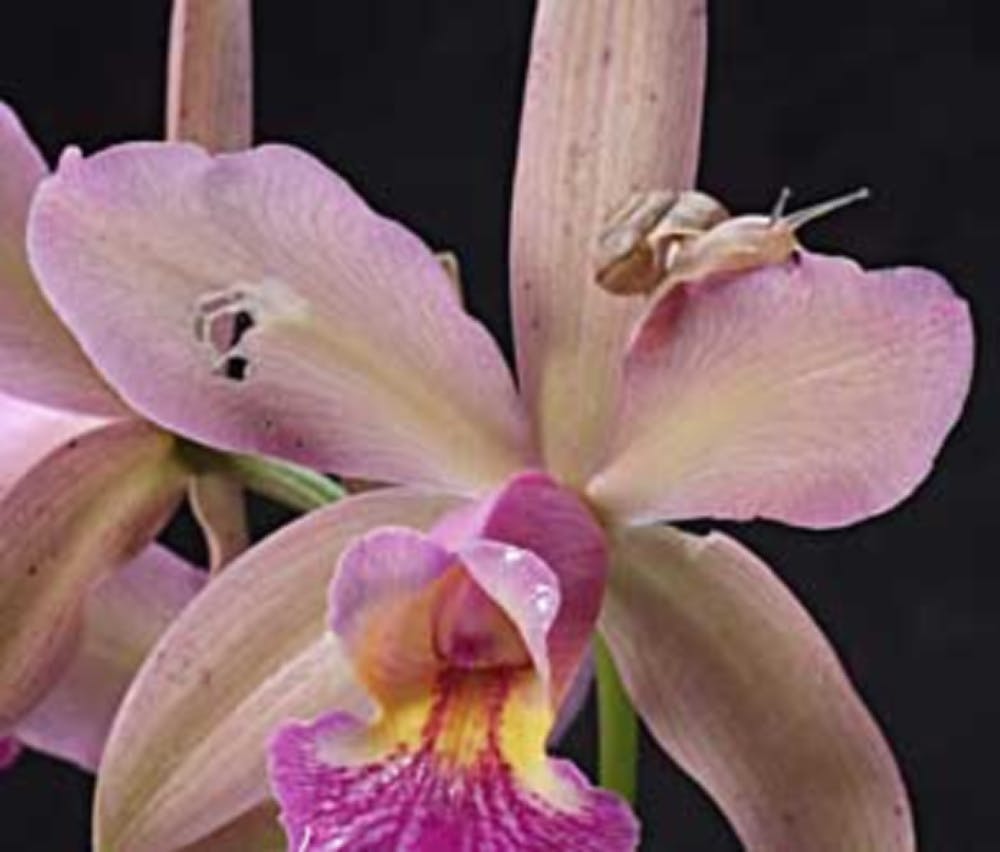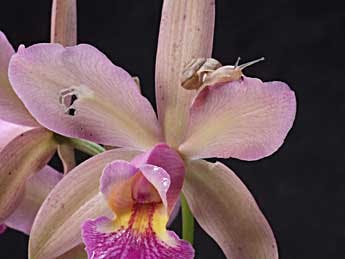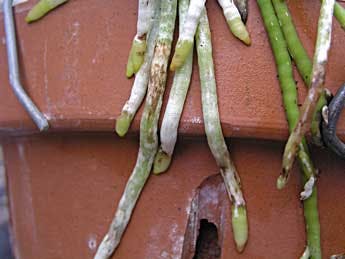
Slugs and Snails


Gallery


Additional Information
All slugs and snails are hermaphrodites, which means that any one individual can mate with any other individual, and both will lay eggs and fertilize the other’s eggs.
In colder climates, slugs and snails will overwinter in topsoil and other debris, such as a compost pile or deep leaf litter. In warmer, more southern climates, slugs and snails will be active all year. Slugs and snails prefer wet or moist conditions, are typically active at night, and avoid dry or dusty places[1]. Typically, slugs reach maturity after about 3 to 6 months, depending on the species, and lay translucent oval to round eggs in clutches of 3 to 40 beneath leaves, in soil cracks, and in other protected areas[2]. Having their entire bodies covered in mucous, they require moist places to live and hide, or they will die. Because of this, they have an aversion to dry dust, ash, diatomaceous earth, etc.
Slugs and snails are very destructive and noticeable. Unlike most other pests which drain or slash the life out of the plant, snails and slugs straight up chew and consume your plants, leaving big holes of irregular shape and somewhat smoothened edges. Signs of slugs include big holes or chew marks or dents in your plant, moist mucous trails on the plant, and typically more damage as the weather gets wetter.
Slugs and snails are nearly 100% an outdoor pest, but if your plants came from the outside, or if you just bought a plant, then you will need to inspect it for slug damage. While some folks salt their slugs in the garden, please be strongly advised that table salt (sodium chloride, or any sodium salt) is extremely toxic to plants. We do not recommend salting to kill slugs. Rather, we recommend cultural changes and baits to mitigate the slug problem. There is no way to eliminate slugs or snails in a greenhouse that has a floor that is soil, or from an outdoor garden. It is, however, possible to eliminate slugs from a greenhouse with a concrete floor that is well sealed at the base. Indoors, it’s very easy to eliminate slugs and snails, once discovered.
Some solutions for slugs and snails include copper wire, iron baits, beer traps, metaldehydes, predators, and more. Just to be explicitly clear – BEER TRAPS DO NOT WORK FOR SLUGS. Do NOT use beer traps to control slugs, as this will just attract even more slugs around, which will steal perfectly good beer and run off to then eat your plants, much like Taco Bell after a night of drinking. The evidence is here in this timelapse, where you can clearly see nearly all the slugs sampling perfectly good beer, then slithering off[3].
Copper sheet barriers have mixed success because the barriers don’t go deep enough (if bordering at ground level into the soil), or are not implemented in a way where the snail or slug can’t avoid the copper sheet. Copper corrodes into copper oxides, which are sharp, crusty, and dry – all things that slugs and snails hate. The downside is, is that too much copper is also toxic to plants. The copper sheet barrier method is most effective with greenhouse benches, where you only have the four (or more) legs of the bench for snails and slugs to crawl up. The idea is to ring the sheet around the legs of the bench so that the slugs and snails from the ground are blocked from climbing up, as they are reluctant to cross the copper sheet barrier. This does not stop slugs or snails from attacking plants, but rather sets a barrier from more entering.
Diatomaceous earth and/or ashes have also been suggested as another barrier method of slug and snail control. These barriers are immediately rendered ineffective when they get wet, as it’s the drying power of the diatomaceous earth/ash that prevents slugs and snails from crossing the barrier.
Truly, the most effective way to eradicate/control slugs and snails is to bait them with iron phosphate pellets, commercially sold as Sluggo. They are naturally attracted to the bait, then are compelled to consume it, then hide away and die. If you have snails or slugs indoors or in a relatively confined area, then it’s possible to eradicate snails and slugs with just the bait. Otherwise, this should be worked into your garden or greenhouse’s IPM program. Remember, slugs and snails are NOT insects, and are impervious to the effects of insecticides.
Allegedly, stories of “having ducks, chickens, or other fowl”[4] will keep your greenhouse free from slugs and snails. We think this works, and support this.
For more information on slugs and snails, see:
- University of Minnesota Extension https://extension.umn.edu/yard-and-garden-insects/slugs#baits-298065
- University of California Agriculture and Natural Resources http://ipm.ucanr.edu/PMG/PESTNOTES/pn7427.html
- Saint Augustine Orchid Society https://staugorchidsociety.org/culturepests-pests.htm
Further Reading
[1] Clemson College Extension https://hgic.clemson.edu/factsheet/snails-slugs-in-the-home-garden/
[2] University of California Agriculture and Natural Resources http://ipm.ucanr.edu/PMG/PESTNOTES/pn7427.html
[3] https://www.youtube.com/watch?v=cf6FHv5x3sc
[4] Anecdotally from growers here in the northeast, but also from http://ipm.ucanr.edu/PMG/PESTNOTES/pn7427.html

FREE ACCESS: Orchid DealWire
Get notified when orchid vendors have special promotions and exclusive savings.








